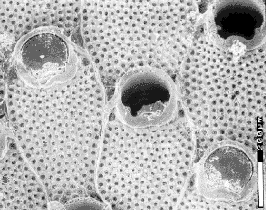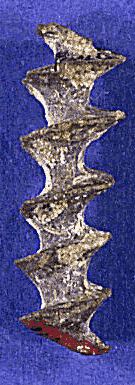
Environmental
SEM photomicrograph of a bryozoan zoarium
shown with permission from the University of California
Museum of Paleontology
Invertebrate Paleontology Lab #4
Bryozoans
Click on the lab title to see the University of
California
Museum of Paleontology web page
Read BEFORE Coming to
Lab:
Benton & Harper, Chapter 12, p.
313-325
Introduction
This week we will start the study of the Lophophorata
by examining the Bryozoan Phylum (aka the Phylum Ectoprocta)
a
group of organisms that feed with a ciliated hollow, crown shaped
structure
called the lophophore, similar to the feeding structure
used
by the Brachiopods (studied in next week's lab) and the Phoronids.
Bryozoans are colonial, mostly (but not entirely) marine
lophophorates.
They appeared in Ordovician time and rapidly diversified, with major
extinctions
in Permian and Triassic time.
A bryozoan colony or zoarium
can be as much as 2 feet across, yet the individual animals, the zooids,
are quite tiny-only about 1 mm in length. The tiny tubular holes
through which the lophophores extend (the zoecia) are much
smaller
than the corallites visible in colonial corals-they are really just
pinhole
sized features. The SEM photograph shown at the top of this page
gives you an idea of what the openings are like.
Bryozoans prefer hard surfaces, and
are often found encrusting upon other shell material. Organisms
that
live on the surface of other organisms are called epibionts,
and
bryozoans are commonly found as epibionts. You will find many examples of
epibionts in your fossils that you will collect at Caesar's Creek, and you will find tiny patches
of bryozoans on the surfaces of the brachiopods and horn corals.
Phylum Bryozoa, (Ordovician-Recent)
| Basic Facts & Terms to Know about Bryozoans: They
are: |
|
| 1. |
Eukaryotes |
| 2. |
Metazoans with organs, true tissues, nervous,
muscular, and
reproductive systems |
| 3. |
characterized by a Lophophore feeding
structure
for benthic filter feeding, a U shaped gut with anus outside
the
lophophore ring. |
| 4. |
Bilateral in symmetry |
| 5. |
free-swimming in larval stage (larvae):
sessile
(encrusting as adults |
| 6. |
able to reproduce sexually and
asexually (through
budding) |
| 7. |
structurally supported by calcium carbonate
exoskeleton called
the zooarium |
| 8. |
Fossil forms are marine, but freshwater forms do
exist.
Sessile and typically encrusting |
| 9. |
Second or third most common fossil of the Paleozoic
(following
brachiopods) |
Part I. Examine the commonly found fossil bryozoans and draw
4,
labelling the zooarium, the zoecium, the Order,, and
the growth habit (massive, branching, encrusting, or fenestrate).
(20 pts)
Part II. Today, we will do a group exercise on cladistics and cladograms (20 pts.).
Notes on Bryozoans
Bryozoan Classification is complex, and recent cladistics analysis
(Anstey, 1990) indicates that many of the traditional Orders are
probably
paraphyletic (that is, each group may have derived from a single
ancestral
taxon, but the group does not include all the common descendents of the
the most recent common ancestor).
Here are the generally recognized Orders for the commonly found
fossil
bryozoans:
Class Stenolaemata (Ordovician-Recent)
Order Trepostomata (Ordovician-Triassic)
Order Cryptostomata (Ordovician-Permian)
Order Fenestrella (Early Ordovician-Permian) This one contains
the index fossil Archimedes, a bryozoan guide fossil for the
Mississippian
Order Cyclostomata (Early Ord-Recent)
Class Gymnolaemata (Ordovician-Recent)
Order Cheilostomata (Jurassic-Recent)
 Archimedes, a
Fenestrate
bryozoan from the Mississippian-commonly preserved without the delicate
branching zoarium.
Archimedes, a
Fenestrate
bryozoan from the Mississippian-commonly preserved without the delicate
branching zoarium.
Shown with permission from the University of California at Berkeley
Museum of Paleontology
